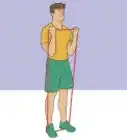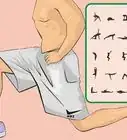This article was co-authored by Danny Gordon and by wikiHow staff writer, Eric McClure. Danny Gordon is an American College of Sports Medicine (ACSM) Certified Personal Trainer and Owner of The Body Studio for Fitness, a fitness studio based in the San Francisco Bay Area. With over 20 years of physical training and teaching experience, he has focused his studio on semi-private personal training. Danny received his Personal Trainer Certification from the California State University, East Bay and the American College of Sports Medicine (ACSM).
There are 21 references cited in this article, which can be found at the bottom of the page.
This article has been viewed 45,867 times.
If you’re building muscle naturally, it simply means that you’re not using supplements or medications to bulk up. This is a great way to get bigger and stronger since it’s safer and more likely to work.[1] By changing up your diet and lifting weights regularly, you can build muscle and improve your overall health. You won’t see results overnight, but with a strict schedule and a little discipline, you’ll see gains in as little as a few months. Remember to see your doctor before making any major changes to your diet or exercise routine. You’ll also need to consult a doctor if you experience extreme pain or strange bruising after working out.
Steps
Training and Working Out
-
1Work out 2-3 times a week to give your muscles healthy breaks. Working out every day is not a particularly good idea. Your muscles need time to repair and it’s important to get some rest in between workout sessions.[2] Leave at least 1 day off in your schedule in between workout sessions.[3]
- You’ll actually build less muscle if you lift every single day. Running daily is fine if you’re looking to trim down your waistline while building muscle, but lifting every day will simply be less effective.
-
2Get a trainer to build a specific workout plan and stay motivated. It’s not mandatory, but getting a personal trainer is a great way to stick with your workout regimen. They’ll also be able to guide you through the proper forms and mechanics for certain exercises.[4] This is a particularly good idea if you’re new to weightlifting and working out.[5]
- You can also ask a friend that lifts regularly to help you out and be your lifting partner if you prefer.
Tip: If you’re going to the gym on your own without a trainer, do not do any heavy lifting with your back or chest if you don’t have a spotter around. If you ever do need a spotter at the gym, feel free to ask another gym member that’s hanging out in between sets. Most weightlifters will be more than happy to spot you.
Advertisement -
3Warm up by stretching and doing light aerobics for 10 minutes before lifting. Before you begin any strength training exercises, it's important to warm up your muscles to prevent pulling a muscle or injuring yourself. Start by touching your toes with your legs straight for 5-10 seconds. Stretch your arms by pulling each arm across your chest and behind your head. Pull your feet up behind you to do some thigh stretches. Then, hop on a treadmill, bike, or do some jumping jacks. Get 10-15 minutes of cardio in before lifting.[6]
- When stretching, it doesn’t necessarily matter if you do any specific stretches so long as you loosen up your legs, arms, chest, and back.
-
4Target your arms using curls and bent rows. These exercises often need a barbell or dumbbells, but they can be done at home without a spotter. If you find that the amount of weight you are using is too easy, try increasing it. Starting off with 10–15 pounds (4.5–6.8 kg) if you aren’t sure where to start. Try doing 3 sets of each exercise with 10-15 reps in each set.[7]
- Bicep curls can be done with a barbell or dumbbells depending on your preference. Hold the weight with your palm facing up and slowly lift the weight towards your shoulders by curling your biceps up before lowering it slowly back to the original position. Hold it for 1 second to complete 1 rep before repeating the process again.
- To do a bent row, put one knee down on a bench and hinge from the waist so your back is flat. Hold a dumbbell in one hand and let it hang down toward the ground. Tense your shoulder, bicep, and forearm. Pull the weight directly up to your chest and lower it back down toward the floor to complete 1 rep. After completing 1 set, swap hands.
-
5Use crunches and leg raises to build your abs up. For many people, the abdominal area is where their weight hangs out, and they often do cardio to achieve that flat belly look. Cardio isn't always enough to create a 6-pack, but these exercises will help you achieve it. Do 10-15 reps each and do 1 set.[8]
- Leg raises are fairly simple and straightforward. Lie on your back with your feet together and keep your legs straight. Raise your legs as high as you can without bending your knees or lifting your butt off of the floor. Once you reach the highest you can go, hold it for 1 second. Then, slowly lower your legs back to 1–2 inches (2.5–5.1 cm) above the ground. Do not let your feet touch the ground and count 1 rep. Repeat this process to complete a set.
- Crunches are also pretty easy in terms of form. To do a crunch, lie down on your back with your knees bent. Put your arms across your chest and raise your upper body up without lifting your lower back. Once you get as high as you can, count 1 rep. Slowly lower yourself back to the ground and stop when you’re 1–2 inches (2.5–5.1 cm) above the ground before completing the rest of the set.
-
6Build your chest up with bench presses and push-ups. These exercises not only build muscle in your chest, but also help increase strength in your shoulders and arms. You can do these at home or in a gym. Keep in mind, you do need a spotter if you’re going to do the bench press.[9]
- You can do a bench press with a barbell or dumbbells. Lay flat on your back on a lifting bench and hoist the dumbbells or barbell directly above your chest. Once your arms are fully extended, hold it for 1 second before lowering your arms down. Stop when the dumbbells or barbells are 3–4 inches (7.6–10.2 cm) from your chest to count 1 rep. Do not hesitate to call a spotter if you need help. Do 5-10 reps based on how much weight you’re using.
- Push-ups are a classic choice. Either do standard push-ups or slide a small platform or ottoman under your feet to increase the resistance on your chest and alleviate pressure on your back. Keep your hands below your shoulder and lower yourself till your chin is 1–2 inches (2.5–5.1 cm) above the ground before pushing yourself back up to do 1 rep. Do 10-20 per set and do 2 sets if possible.
-
7Target your legs with squats and leg curls. These exercises will target your butt, glutes, and legs. Use a dumbbell or barbell for these exercises and try to do three sets of each exercise with 10 to 15 repetitions.[10]
- To do a squat, take a heavy dumbbell or barbell and hold it in in your hands, stand up straight placing your feet shoulder width apart. Bend your knees so your thighs are parallel to the floor while keeping your back straight. Hold your position for 1-2 seconds before raising yourself up to count 1 rep.
- You have to do leg curls at the gym on a leg bench machine. Lie down on your stomach and slide your feet under the footpads. Use your knees to curl your calves up and pull the weights up towards your butt. Once you raise the footpads up as high as you can, lower the weights slowly to count 1 rep.
-
8Set a goal for yourself to build muscle up over time. You may want to bulk up fast, but remember that building real muscle takes time. Determine how much muscle you want to build and take a “before” photo so you can gauge your progress over time. For the next few months, be sure to get adequate sleep, prepare to cut out the junk food, and go grocery shopping to pick up some good proteins and carbs for your fridge.[11]
- Set a date where you’re going to start, but don’t focus too much on an end date. Everyone’s process is different and it can take anywhere from 1 month to a year to bulk up depending on your age, diet, and metabolism.
Adjusting Your Diet
-
1Increase your daily caloric intake to raise your body mass. If you are burning all the calories you eat, working out and burning fat will make you thinner. For most people, consuming an additional 300-500 calories a day is more than enough to bulk up while working out regularly. Keep in mind, these calories should be equally consumed through proteins, carbohydrates, and a little bit of fat.[12]
- Make sure you are eating the right kinds of foods during the day. You don't want to increase your daily caloric consumption by eating lots of junk food.
- Adult men normally need around 2,400 calories a day while women need around 2,000. These caloric requirements differ a little based on age, weight, and height. Talk to a nutritionist or doctor to determine how many calories you need.
-
2Consume a protein-rich breakfast every day to start burning fat. In the morning, be sure to eat eggs, lean sausage, Greek yogurt, or some other protein-rich food. Eating early in the morning jumpstarts your metabolism and tells your body that it’s time to start burning energy. This will not only make it easier to lose the bad weight, but the protein will help your muscles stay strong and healthy as they get bigger.[13]
- A good sample breakfast might be a small cup of yogurt, an egg, and a few low-fat sausage links.
- Don’t eat so much in the morning that you feel tired and sluggish during the day.
-
3Eat more frequently throughout the day and have a smaller dinner. Instead of sticking to the usual 3 meals a day, you’ll have an easier time building muscle with 4-5 meals. This will also help you reach your caloric target. Eating more meals will increase your metabolism and energy levels which will make it easier to build muscle.[14]
- Make your last daily meal a little smaller than your breakfast or lunch. Since your metabolism is lower late at night, eating a lot after 5 pm may help you put on weight, but it won’t build muscle.
-
4Drink plenty of water to stay hydrated, especially before working out. It's important to make sure you aren't dehydrated with your increased diet and workout routine. Consume roughly 17–20 fl oz (500–590 mL) of water at least 2 hours before working out. While you’re lifting or running, drink 7–10 fl oz (210–300 mL) of water every 10-20 minutes. After you’re done, have 16–24 fl oz (470–710 mL) of water for every 1 lb (0.45 kg) you lost through your sweat to stay properly hydrated.[15]
Tip: Water keeps your energy levels up, regulates your body temperature, and helps you with digestion and nutrient absorption, all of which are important when trying to build muscle.
-
5Get roughly 25-30% of your daily calories from protein. Everyone’s body is different, but protein is a major contributor when it comes to building muscle mass. Since protein repairs muscle tissue, it’s extremely important to get at least 25% of your diet from protein when you’re bulking up.[16]
- Fresh salmon with a side of broccoli or potatoes is a great way to get some protein. You could also make something using grilled chicken, a beef stew, or a tofu dish.
- Good options when it comes to protein include lean beef, chicken, eggs, almonds, broccoli, and Greek yogurt.
- Stay away from junk food and soda if you’re trying to build muscle!
-
6Eat enough carbohydrates to make them roughly 55-60% of your diet. Carbohydrates are essential when it comes to producing energy. Since you’ll be using a lot more energy than most people by working out every other day or so, getting plenty of carbs is key to building muscle. One easy way to do this is to have a carb with each meal every day. You could also eat a single carbohydrate-heavy dish, like pasta.[17]
- Solid carbohydrates include any vegetable, salmon, nuts, chickpeas, lentils, and potatoes.
- For meals, you could make some sweet potatoes, mixed greens, with a protein. You can also get a ton of carbs from pasta, which can be prepared a variety of different ways.
-
7Make fiber, oils, and healthy fats the remaining 15-20% of your calories.[18] Fiber is crucial for helping your body digest while healthy oils like olive oil and almond oil contain a variety of acids that your body needs. The oils will also help reduce inflammation which you may run into while working out regularly.[19] For fat, try to limit your intake and stick with healthy fats found in cheese, avocado, and quinoa.[20]
- Foods that are rich in fiber include basically any fruit and vegetable. Throw in some veggies with at least one of your meals to make sure that you get enough fiber.
- Popcorn with a little oil and no butter or salt is a healthy nutritious snack that’s rich in fiber and oil.
When to Seek Medical Care
-
1Talk to your doctor about exercising safely. The types of exercise you can do safely depend on a lot of factors, like your fitness level, current weight, age, and overall health. Before you take on a strenuous new workout routine, see your doctor. They can tell you what kinds of exercise are likely to benefit you the most, and help you avoid exercises that might lead to injury.[21]
- For example, if you struggle with arthritis or another musculoskeletal condition, your doctor or physical therapist can help you choose exercises that will help you build muscle mass without putting strain on your joints.
- Ask your doctor to recommend a physical therapist or certified personal trainer who can help you develop a healthy exercise plan.
-
2Consult your doctor before making major dietary changes. Your nutritional needs will also vary depending on a lot of individual factors, such as your age, sex, overall health, and current dietary habits. A doctor or registered dietitian can help you determine how much you need to eat in order to build muscle in a healthy way.[22]
- They can also advise you about which foods are healthiest for you. Let your doctor know if you have any health conditions that might affect what you can safely eat, such as diabetes, high blood pressure, or kidney disease.
-
3Seek medical help if you have concerns about your muscle mass. If you're having trouble building muscle or gaining weight, make an appointment to talk to your doctor. They may be able to determine if there is an underlying condition (such as a thyroid problem or a nutrient deficiency) that's making it harder for you to build muscle mass.[23]
- Give your doctor detailed information about your current diet and exercise habits, your health history, and any medications or supplements you're currently taking.
-
4Get medical advice before trying any supplements. While some dietary supplements, like glutamine, can help you build muscle in a healthy way, others may do more harm than good. Additionally, supplements can sometimes interact badly with medications or other supplements, sometimes causing serious side effects. Before starting any new supplement, talk to your doctor about whether it's a good idea for you.[24]
- Give your doctor a full list of any prescription or over-the-counter medications you are currently taking, as well as any other vitamins or dietary supplements.
- Let your doctor know if you have any medical conditions or health concerns that might affect which supplements you can safely take, such as pregnancy, kidney or liver disease, or a blood clotting disorder.
-
5See your doctor if you have severe pain after working out. It's normal to feel a little sore after working out, especially if you're not used to using those muscles. However, some types of pain after exercise might mean that you have an injury.[25]
See a doctor if you experience any of these symptoms:
Sharp or severe pain that makes it difficult to move any part of your body, or pain that is constant or keeps getting worse over time.
Pain with obvious swelling, deformity, bruising, or a feeling of pressure.
Pain that doesn't get better with rest, ice, or over-the-counter pain medications.
Pain accompanied by nausea, vomiting, fever, or chills.
Expert Q&A
-
QuestionShould I use supplements like creatine or pre-workout to aid my fitness routine?
 Danny GordonDanny Gordon is an American College of Sports Medicine (ACSM) Certified Personal Trainer and Owner of The Body Studio for Fitness, a fitness studio based in the San Francisco Bay Area. With over 20 years of physical training and teaching experience, he has focused his studio on semi-private personal training. Danny received his Personal Trainer Certification from the California State University, East Bay and the American College of Sports Medicine (ACSM).
Danny GordonDanny Gordon is an American College of Sports Medicine (ACSM) Certified Personal Trainer and Owner of The Body Studio for Fitness, a fitness studio based in the San Francisco Bay Area. With over 20 years of physical training and teaching experience, he has focused his studio on semi-private personal training. Danny received his Personal Trainer Certification from the California State University, East Bay and the American College of Sports Medicine (ACSM).
Certified Personal Trainer
References
- ↑ https://news.brown.edu/articles/2015/04/muscles
- ↑ Danny Gordon. Certified Personal Trainer. Expert Interview. 18 October 2019.
- ↑ https://www.health.harvard.edu/exercise-and-fitness/7-tips-for-a-safe-and-successful-strength-training-program
- ↑ Danny Gordon. Certified Personal Trainer. Expert Interview. 18 October 2019.
- ↑ https://www.ncbi.nlm.nih.gov/pmc/articles/PMC3937569/
- ↑ https://www.bu.edu/articles/2015/stretch-before-exercise-not-so-fast/
- ↑ https://www.health.harvard.edu/exercise-and-fitness/the-4-most-important-types-of-exercise
- ↑ https://www.health.harvard.edu/healthbeat/core-conditioning-its-not-just-about-abs
- ↑ https://www.health.harvard.edu/blog/rise-push-ups-classic-exercise-can-motivate-get-stronger-2019021810165
- ↑ https://hr.duke.edu/wellness/runwalk-club/training-education/strengthen-your-legs
- ↑ https://haenfler.sites.grinnell.edu/subcultures-and-scenes/bodybuilders/
- ↑ https://macalester_ftp.sidearmsports.com/custompages/Deno_Videos/nutrition/nutrition_for_strength_and_power_athletes.pdf
- ↑ https://www.ncbi.nlm.nih.gov/pubmed/26239831
- ↑ https://www.ncbi.nlm.nih.gov/pubmed/18384284
- ↑ http://www.med.umich.edu/1libr/Mhealthy/TheImportanceofWaterWhileExercising.pdf
- ↑ Danny Gordon. Certified Personal Trainer. Expert Interview. 18 October 2019.
- ↑ Danny Gordon. Certified Personal Trainer. Expert Interview. 18 October 2019.
- ↑ Danny Gordon. Certified Personal Trainer. Expert Interview. 18 October 2019.
- ↑ https://www.health.harvard.edu/staying-healthy/the-truth-about-fats-bad-and-good
- ↑ https://www.mayoclinic.org/healthy-lifestyle/nutrition-and-healthy-eating/in-depth/high-fiber-foods/art-20050948
- ↑ https://www.ncbi.nlm.nih.gov/pmc/articles/PMC6074643/
- ↑ https://news.usc.edu/135551/fasting-aging-dieting-and-when-you-should-eat-valter-longo/
- ↑ https://www.betterhealth.vic.gov.au/health/healthyliving/weight-and-muscle-gain
- ↑ https://www.nhs.uk/live-well/healthy-body/body-building-sports-supplements-facts/
- ↑ https://health.clevelandclinic.org/is-your-exercise-causing-good-or-bad-pain-how-to-tell/
About This Article
To build muscle naturally, eat healthy, muscle-building foods, like eggs, nuts, lean beef, salmon, and cottage cheese. Also, do strength-training exercises to build your muscles, like bicep curls, crunches, push-ups, squats, and lunges. Try to do a variety of exercises so you're targeting all of your different muscle groups. Then, whenever you finish a workout, eat some protein, which will help your muscles recover and grow. For tips on how to build muscle at an older age, scroll down!
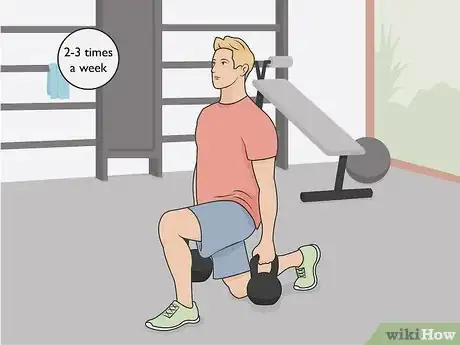


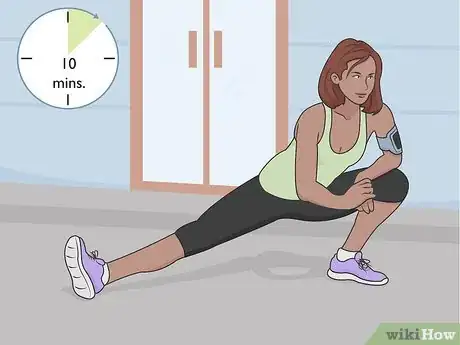
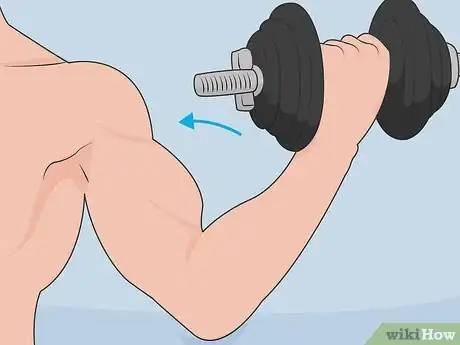
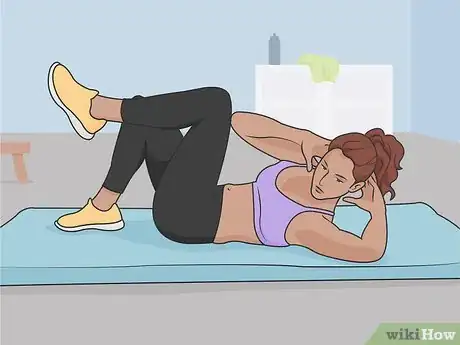
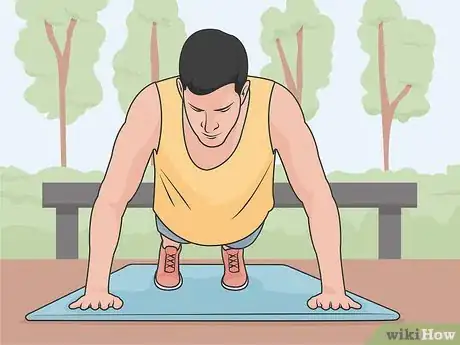
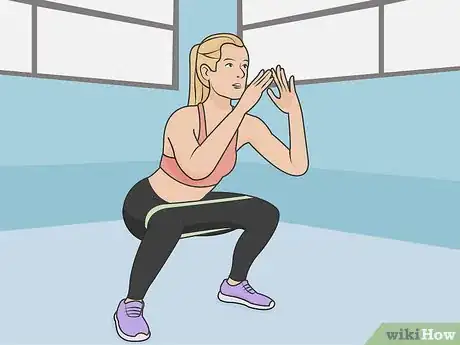
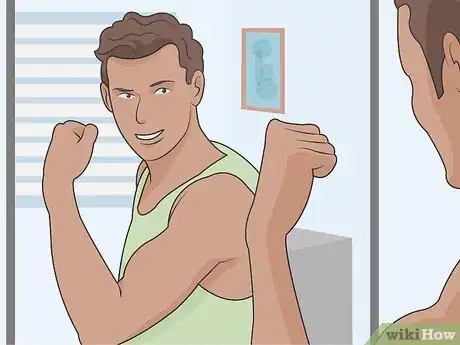

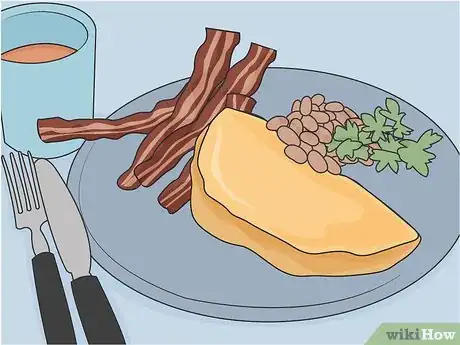
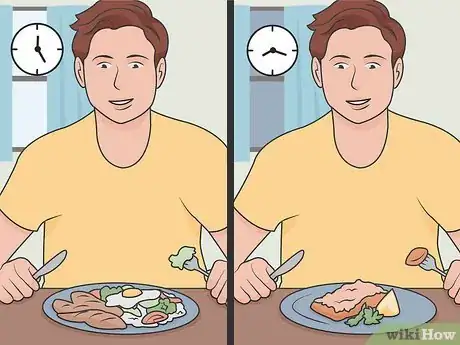
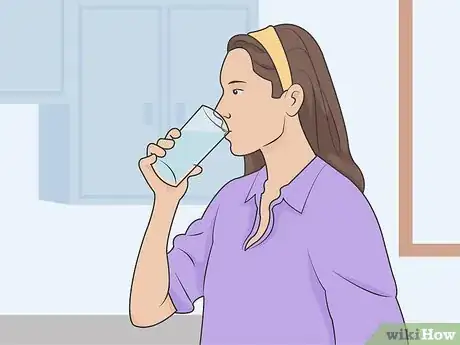
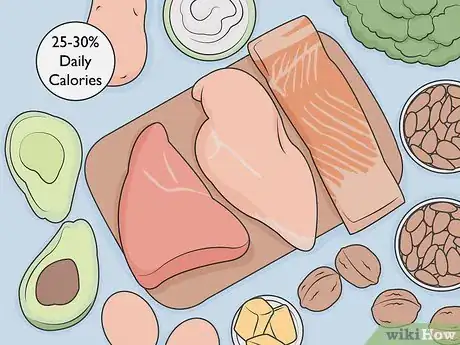
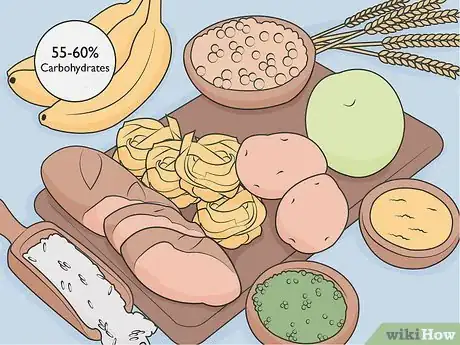
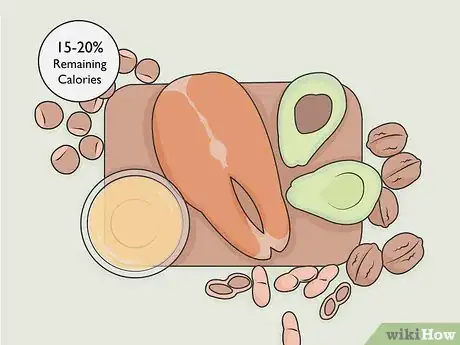
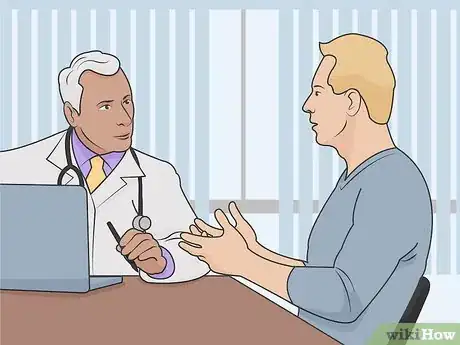
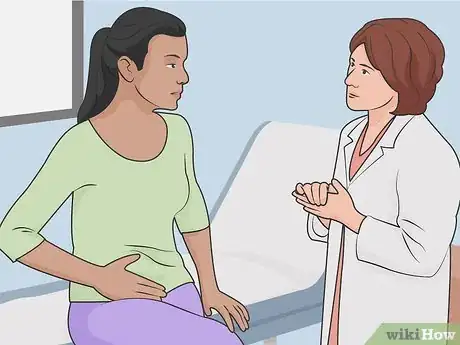
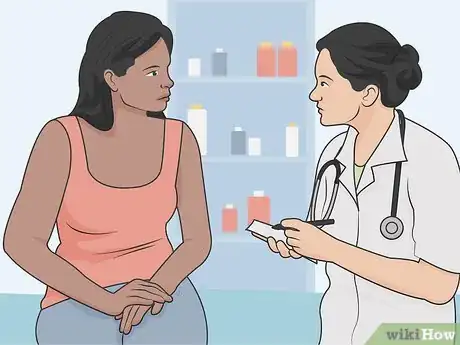
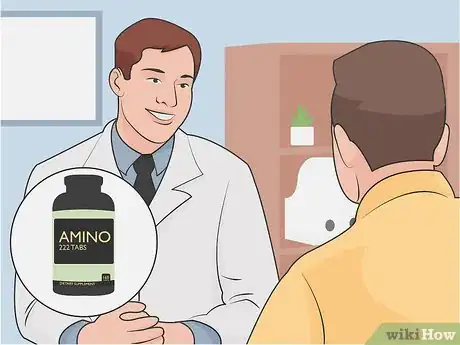
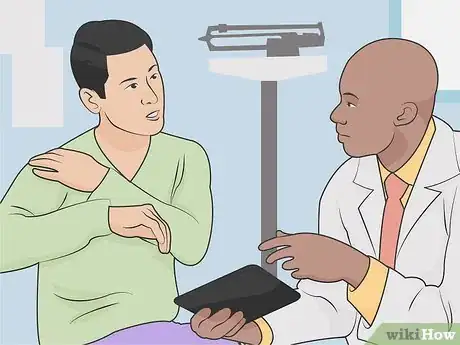

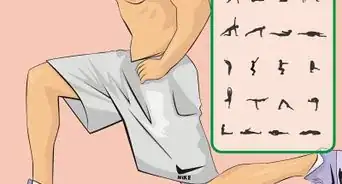

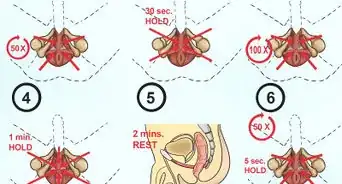

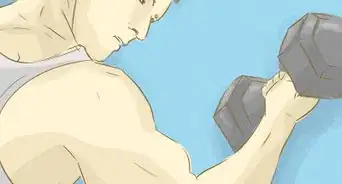
-Step-24.webp)










